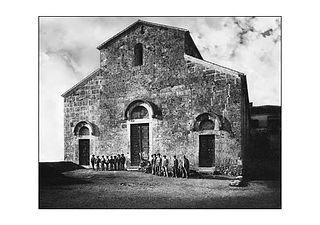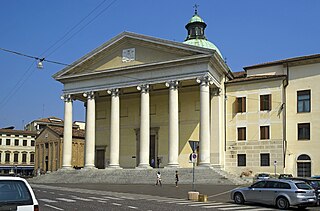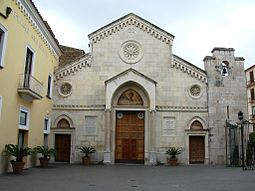History
In the tenth century Sorrento became a metropolitan see. Previous to that time it had been directly dependent upon the Holy See (Papacy), and its bishops attended the Roman synods.
In 1558 the Turks under Piyale Pasha effected a landing at Salerno, and plundered and burned the city, on which occasion the archives perished. The new bishop, Giulio Pavesi, sought to repair the damages. Bishop Filippo Anastasi (1699) defended the immunities of the Church and was forcibly exiled to Terracina.
Cathedral and Chapter
The cathedral of Sorrento was dedicated to the Apostles Philip and James. The cathedral has the care of souls (cura animarum), who are in the care of the Dean of the Chapter. [3]
The cathedral was staffed and administered by a corporation, the Chapter, composed of five dignities (the Archdeacon, the Primicerius, the Cantor, the Dean, and the Treasurer) and twelve Canons. [4]
Archbishop Giulio Pavesi presided over a provincial synod in 1567. Archbishop Lelio Brancaccio (1571–1574) presided over a provincial synod in 1574. [5]
Bishop Antonio de Pezzo (1641–1659) presided over a diocesan synod in Sorrento in 1654. [6] Bishop Gabriele Papa (1824–1837) held a diocesan synod in the cathedral of Sorrento on 5–8 June 1827. [7]
Bishop Diego Pietra (1680) founded the seminary, afterwards enlarged by Bishop Filippo Anastasi (1699).
Concordat of 1818
Following the extinction of the Napoleonic Kingdom of Italy, the Congress of Vienna authorized the restoration of the Papal States and the Kingdom of Naples. Since the French occupation had seen the abolition of many Church institutions in the Kingdom, as well as the confiscation of most Church property and resources, it was imperative that Pope Pius VII and King Ferdinand IV reach agreement on restoration and restitution. Ferdinand, however, was not prepared to accept the pre-Napoleonic situation, in which Naples was a feudal subject of the papacy. Lengthy, detailed, and acrimonious negotiations ensued.
In 1818, a new concordat with the Kingdom of the Two Sicilies committed the pope to the suppression of more than fifty small dioceses in the kingdom. Pope Pius VII, in the bull "De Utiliori" of 27 June 1818, suppressed the dioceses of Massa Lubrense, Vico Equense (Vicana), and Capri, and their territories were added to Sorrento. Sorrento was left with only one suffragan, the diocese of Castellamare. [8] In the same concordat, the King was confirmed in the right to nominate candidates for vacant bishoprics, subject to the approval of the pope. That situation persisted down until the final overthrow of the Bourbon monarchy in 1860. [9]
In 1860, the Bourbon monarchy in the south of Italy and Sicily was permanently suppressed, and the Kingdom of the Two Sicilies became part of the Savoyard Kingdom of Italy. Many of the clergy in the south followed the lead of Pius IX in resisting the king of Turin, who had annexed the entire Papal States, with the exception of the city of Rome. In 1861, Archbishop Francesco Apuzzo of Sorrento was, by order of the new Government, exiled to France.
Loss of metropolitan status
Following the Second Vatican Council, and in accordance with the norms laid out in the Council's decree, Christus Dominus chapter 40, [10] major changes were made in the ecclesiastical administrative structure of southern Italy. Wide consultations had taken place with the bishops and other prelates who would be affected. Action, however, was deferred, first by the death of Pope Paul VI on 6 August 1978, then the death of Pope John Paul I on 28 September 1978, and the election of Pope John Paul II on 16 October 1978. Pope John Paul II issued a decree, "Quamquam Ecclesia," on 30 April 1979, ordering the changes. Three ecclesiastical provinces were abolished entirely: those of Conza, Capua, and Sorrento. A new ecclesiastical province was created, to be called the Regio Campana, whose Metropolitan was the Archbishop of Naples. The archbishop of Sorrento continued to enjoy the title of Archbishop, but he was no longer a metropolitan archbishop. [11]
Acquisition of territory
On 18 February 1984, the Vatican and the Italian State signed a new and revised concordat, which was accompanied in the next year by enabling legislation. According to the agreement, the practice of having one bishop govern two separate dioceses at the same time, aeque personaliter, was abolished. The Vatican continued consultations which had begun under Pope John XXIII for the merging of small dioceses, especially those with personnel and financial problems, into one combined diocese. [12] On 30 September 1986, Pope John Paul II ordered that the dioceses of Sorrento and Castellamare be merged into one diocese with one bishop, with the Latin title Archidioecesis Surrentina-Castri Maris. The seat of the diocese was to be in Sorrento, and the cathedral of Sorrento was to serve as the cathedral of the merged diocese. The cathedral in Castellamare was to become a co-cathedral, and the cathedral Chapter was to be a Capitulum Concathedralis. There was to be only one diocesan Tribunal, in Sorrento, and likewise one seminary, one College of Consultors, and one Priests' Council. The territory of the new diocese was to include the territory of the former dioceses of Sorrento and of Castellamare. [13]

The Archdiocese of Ancona–Osimo is a Latin Church ecclesiastical territory and metropolitan see of the Catholic Church in the Marche region of Italy.

The Diocese of Nola is a Latin diocese of the Catholic Church in Italy, suffragan of the Archdiocese of Naples. Its seat is the Campanian city of Nola, now a suburb of Naples. Its cathedral is dedicated to the Assumption. The dedication was originally to S. Stephen, the Protomartyr, but after the second reconstruction the dedication was changed to the Assumption. It is traditionally credited with the introduction of the use of bells into Christian worship.

The Archdiocese of Capua is a Latin diocese of the Catholic Church in Capua, in Campania, Italy, but its archbishop no longer holds metropolitan rank and has no ecclesiastical province. Since 1979, it is a suffragan of the Archdiocese of Napoli, i.e. no longer has its own ecclesiastical province nor metropolitan status.

The Archdiocese of Gaeta is a Latin Church ecclesiastical territory or archdiocese of the Catholic Church in southern Italy, in the city of Gaeta, in the Lazio region. The archbishop's cathedra is located in the Cathedral of SS. Erasmus and Marcianus and the Assumption of the Virgin Mary in the episcopal see of Gaeta. A non-metropolitan see, the archdiocese is immediately exempt to the Holy See.

The Archdiocese of Otranto is a Latin archdiocese of the Catholic Church in Italy. The seat of the diocese is at Otranto Cathedral in the city of Otranto, Apulia. It is a suffragan of the archdiocese of Lecce.

The Roman Catholic Diocese of Ferentino existed until 1986, when it was united into the new diocese of Frosinone-Veroli-Ferentino.

The Archdiocese of Reggio Calabria-Bova is a Latin Church ecclesiastical territory or diocese of the Catholic Church in Calabria, southern Italy. It received its current title in 1986, when the independent Diocese of Bova was suppressed, and the territory and title of the diocese added to that of the Archdiocese of Reggio.

The Diocese of Bovino is a Latin Church diocese of the Catholic Church in the civil province of Apulia, southern Italy. It is 23 mi (37 km) southwest of Foggia. It was established in the tenth century, and was a suffragan of the archdiocese of Benevento. In 1986 it was merged into the Archdiocese of Foggia-Bovino. In 1980, the diocese claimed 23,500 adherents, served by 26 priests.

The Diocese of Nocera Umbra was a Catholic diocese in Umbria, Italy.

The Italian Catholic diocese of Todi existed until 1986, when it was united into the diocese of Orvieto-Todi. Up until that point, the diocese had always been directly dependent on the Holy See.

The Diocese of Orvieto-Todi is a Latin Church ecclesiastical territory or diocese of the Catholic Church in central Italy. It was created in 1986 when the historical Diocese of Orvieto was united to the Diocese of Todi. The Diocese of Orvieto-Todi is immediately exempt to the Holy See and not part of any ecclesiastical province.

The Archdiocese of Crotone-Santa Severina is a Latin Church diocese of the Catholic Church in Calabria in southern Italy, created in 1986 when it was combined with the Diocese of Santa Severina. It is now a suffragan of the Archdiocese of Catanzaro-Squillace. In 2013 there was one priest for every 1,841 Catholics.

The Diocese of Foligno is a Latin Church ecclesiastical territory or diocese of the Catholic Church in Umbria, Italy. It is a suffragan diocese in the ecclesiastical province of the metropolitan Archdiocese of Perugia-Città della Pieve.

The Diocese of Treviso is Latin Church ecclesiastical territory or diocese of the Catholic Church in the Veneto, Italy. It is a suffragan diocese in the ecclesiastical province of the metropolitan Patriarchate of Venice.

The Diocese of Cesena-Sarsina is a Latin diocese of the Catholic Church in Emilia Romagna was created on September 30, 1986, after the Diocese of Sarsina was united with the historic Diocese of Cesena as a suffragan of the Archdiocese of Ravenna-Cervia.

The diocese of Teano-Calvi is a Latin diocese of the Catholic Church in Campania, southern Italy, created in 1986. It is a suffragan of the Archdiocese of Naples. The historic Diocese of Teano and diocese of Calvi Risorta were united in 1818, forming the diocese of Calvi e Teano.

The Diocese of Pozzuoli is a Latin diocese of the Catholic Church in Campania, southern Italy. It is a suffragan of the Metropolitan Roman Catholic Archdiocese of Naples, like its other neighboring dioceses, Aversa and Ischia.

The Diocese of Caserta is a Latin diocese of the Catholic Church in Campania, southern Italy. It is a suffragan of the Archdiocese of Naples. In 1818 Pope Pius VII united this see with the diocese of Caiazzo, but Pope Pius IX made them separate sees. In 2013 in the diocese of Caserta there was one priest for every 1,703 Catholics; in 2016, there was one priest for every 2,008 Catholics. The diocesan Major Seminary currently (2019) has four seminarians.

The Diocese of Sessa Aurunca is a Latin diocese of the Catholic Church in southern Italy. Since 1979 it has been a suffragan of the Archdiocese of Naples.

The Diocese of Anagni-Alatri is a Latin Church ecclesiastical territory or diocese of the Catholic Church in Lazio, Italy. It has existed in its current form since 1986. In that year the Diocese of Alatri was united to the historical Diocese of Anagni. The diocese is immediately exempt to the Holy See.





















